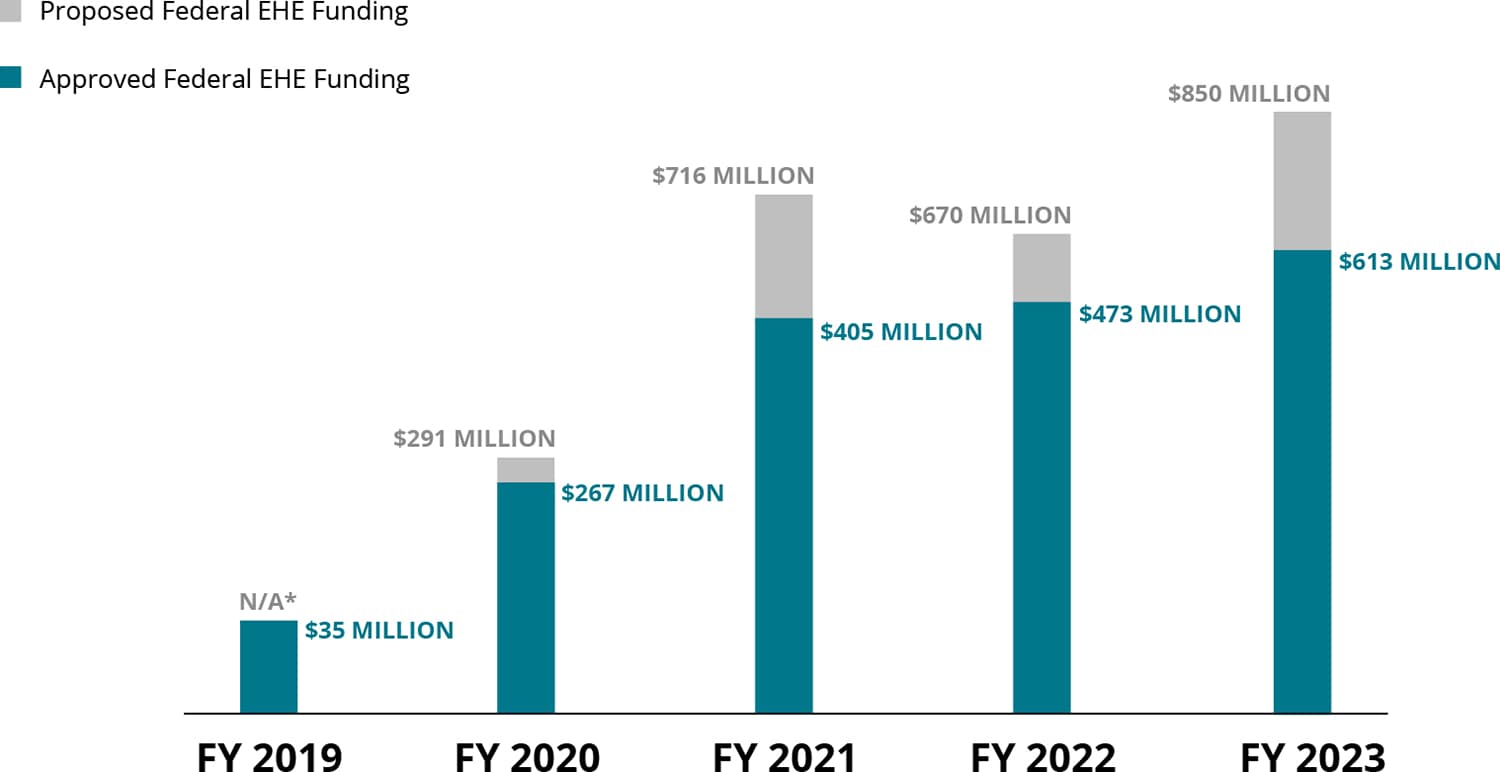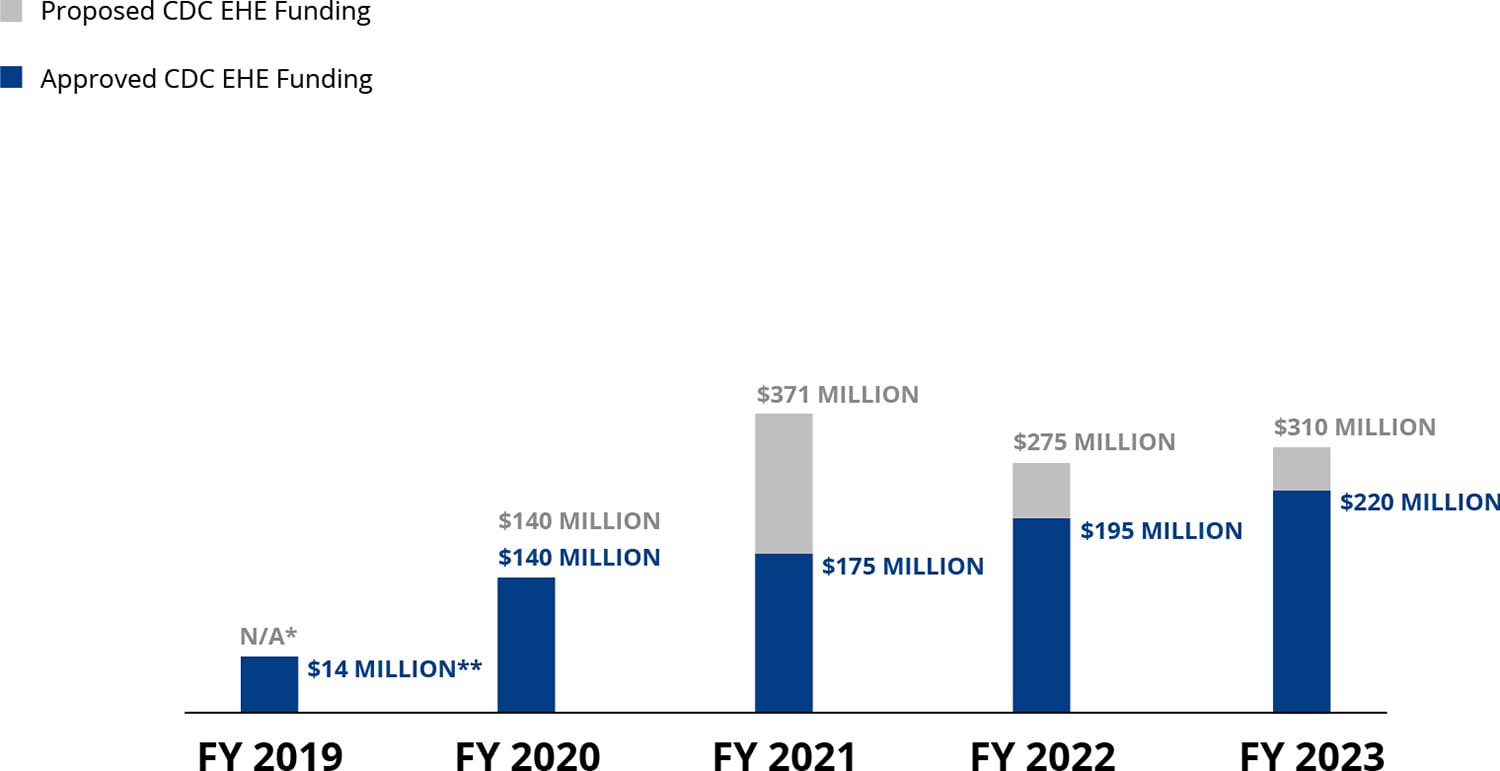Visit the COVID-19 and HIV page for the latest updates on the novel coronavirus outbreak and HIV.

Current and Past Funding for Ending the HIV Epidemic in the U.S.
Ending the HIV Epidemic in the U.S. (EHE) is a whole-of-society initiative with the ambitious goal of reducing new HIV infections by 90% by 2030 and advancing health equity. Through EHE, 57 jurisdictions hardest hit by HIV receive funding to design and implement community-centered and locally tailored solutions that reach people with and affected by HIV with the care and prevention services they need.
To reach EHE’s 2025 and 2030 goals, significant investments will be required to scale up EHE’s core strategies and to accelerate the identification and implementation of innovative solutions for delivering HIV prevention and care beyond these 57 jurisdictions. With the necessary resources in place, communities across the nation could use EHE strategies to implement proven HIV prevention strategies and move the nation closer to ending the HIV epidemic once and for all.
The charts below outline the EHE funding levels proposed in the President’s budget requests for Fiscal Years (FY) 2019-2023 and the total amounts approved and appropriated by Congress to support the initiative. Since 2020, actual funding has been less than the amount requested by the President. Ending the U.S. HIV epidemic will require accelerated investments to scale up EHE’s core strategies and innovations across the country.
Proposed vs. Approved Federal Funding for EHE Across Agencies, FY2019-FY2023

*No funding request for FY2019, first year EHE funding was drawn from pre-existing HIV funding.
Proposed vs. Approved Federal Funding for CDC’s EHE Activities, FY2019-FY2023

*No funding request for FY2019
**FY 2019 funding was reallocated from other sources and does not represent a congressional appropriation.
Milestones
Since EHE was announced in February 2019, CDC and its partners have reached several important milestones, including regularly releasing crucial funding to health departments and community-based organizations to build local capacity and scale up proven strategies. See below for a list of CDC milestones since EHE was launched.
- CDC released a Science Brief: Evidence That HIV Cluster and Outbreak Detection and Response Strengthens HIV Prevention and Care Services. This Science Brief summarizes the evidence that HIV cluster detection and response is an essential public health service that guides HIV prevention resources to the people and places that need them
- CDC announced the launch of Together TakeMeHome, a partnership-based project with the goal of distributing up to 1 million HIV self-tests in the United States and Puerto Rico over the next five years
- CDC released five funding opportunities for research activities on key HIV prevention issues, including:
- CDC released the HIV Criminalization Legal and Policy Assessment Tool, which enables an objective assessment of a jurisdiction’s laws, regulations, and executive orders that control HIV surveillance and prevention. The tool can also help identify opportunities to strengthen legal and policy protections for people with HIV—protections that are also likely to benefit public health more broadly—by aligning them with evidence-based best practices
- The U.S. Business Action to End HIV coalition was launched by Health Action Alliance and ViiV Healthcare to leverage the expertise of the private sector in support of advancing EHE goals
- CDC released the Division of HIV Prevention (DHP) Strategic Plan Supplement: An Overview of Refreshed Priorities for 2022–2025. This document supplements DHP’s 2017-2020 Strategic Plan and aligns with goals outlined in the 2022-2025 National HIV/AIDS Strategy (NHAS) and EHE
- CDC awarded more than $120 million to state and local health departments to support the acceleration of HIV prevention and treatment efforts. This additional funding allowed national and community-based organizations to employ innovative HIV prevention solutions, including:
- Expansion of self-testing;
- Linkage to PrEP in non-traditional healthcare settings;
- Implementation of status neutral service delivery models;
- Prevention, treatment, and care for syndemic infections in STI clinics; and
- Capacity building and technical assistance for EHE jurisdictions
- CDC awarded $2 million to four organizations to develop models for community-to-clinic, status neutral HIV prevention and care services for transgender people
- CDC awarded approximately $14.4 million in first-year funding to 36 community-based organizations to develop and implement high-impact HIV prevention programs for young gay and bisexual men of color, young transgender people of color, and their partners
- CDC launched an ongoing series of regional community engagement sessions to understand and address the longstanding inequities that continue to contribute to severe HIV-related disparities and to work together to advance EHE
- CDC updated the PrEP Clinical Practice Guideline, recommending that healthcare providers inform all sexually active adults and adolescents about PrEP and offer PrEP to anyone who requests it. In addition, DHP revised flagship health department program guidance to allow funding flexibility to support coverage of PrEP ancillary services
- CDC awarded supplemental funding to expand regional TA to directly funded community-based organizations and their clinical and public health partners. This TA was focused on the delivery of status neutral and culturally competent care and services for transgender people
- CDC awarded $117 million to state and local health departments to advance innovation and health equity, and help HIV programs regain momentum following COVID-19.
- This includes more than $11 million across 19 communities to scale up quality HIV prevention services in STI clinics
- CDC distributed 100,000 free HIV self-test kits to populations disproportionately affected by HIV, including transgender women and racial/ethnic minority communities
- EHE jurisdictions submitted updated local plans
- CDC hired and sent seven Public Health Field Assignees to EHE jurisdictions across the country to increase the HIV workforce capacity of health departments in these areas
- CDC awarded $2 million in EHE supplemental capacity-building assistance funds to four regional technical assistance providers to assist local areas with community engagement related to EHE
- HHS launched America’s HIV Epidemic Analysis Dashboard (AHEAD), a tool that provides national and jurisdictional data from CDC on the six EHE indicators
- The Minority HIV/AIDS Fund released a new investment to address under-resourced STD clinics to bolster training and technical assistance efforts for STD specialty clinics to better provide HIV prevention services